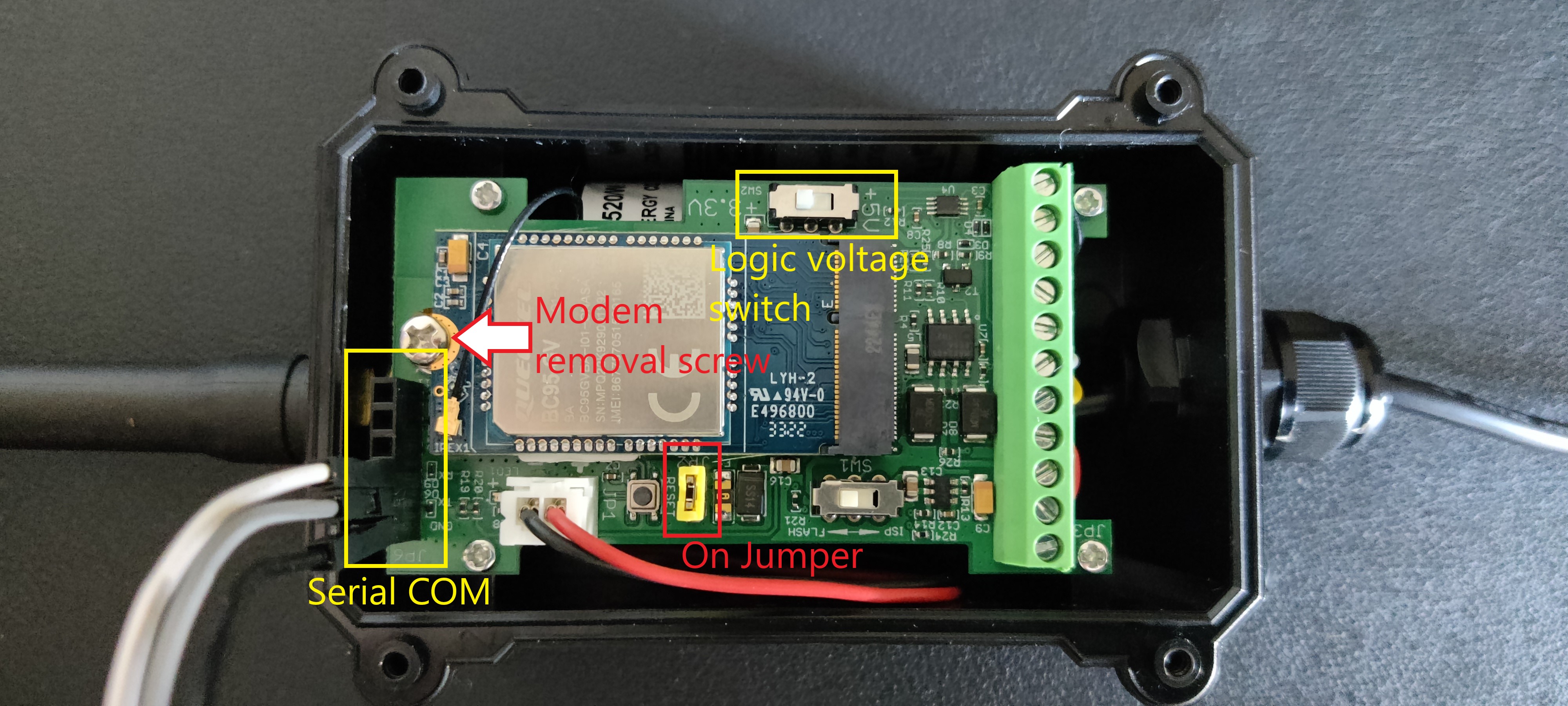Dragino Soil PH sensor NSPH01

The Dragino NSPH01 is a NB-IoT soil pH sensor for IoT of Agriculture. It is designed to measure the soil pH and soil temperature, so to send data to an IoT server to analyze the soil acid or alkali level. The probe is IP68 waterproof.
It supports sending data through UDP, MQTT and COAP over NB-IoT.
Useful resources
Find here the useful resources:
Configuring the device
Register the device
The imei can be found on the top cover of the device, please register the device in your iotcreators project before attempting to connect the device to the network.
Register the device
Opening the device
Connect the antenna to the device, then unscrew the four screws that hold the waterproof cover in place. This is the top view of the board:

Inserting the sim card
To mount the sim card into the sim card tray, unscrew the "modem removal screw" as showed above and insert the sim card.
Please be sure to insert the sim card as shown in this photo:

Connecting the device to a computer
To connect the device to a computer, you will need a usb to serial converter, which supports 3V3 or 5V logic. The logic voltage level can be selected with the "logic voltage switch" switch.
Set the correct voltage level
Please carefully setup the correct voltage level (3.3 or 5 volts) according to your usb-to-serial converter. Failing to do so may unrecoverably damage your device!
You need 3 cables to connect the device to a serial monitor: GND (ground), TX (transmit) and RX (receive).
Just connect the RX of the dragino sensor to the TX of the usb-to-serial converter, the TX of the dragino sensor to the RX of the usb-to-serialconverter and the GND of the dragino sensor to the GND of the usb-to-serial converter.
Baudrate must be set to 9600 bps
First startup
To boot up the device, please set up the power on jumper as shown in section "Opening the device" to power on the device. Please make sure that the device is correctly attached to a computer.
Open your favourite serial monitor (for example: miniterm on linux or arduino serial monitor on windows) and the device will start to output info about its startup like so:
16:24:32.861 -> [12589]NBIOT has responded.
16:24:37.191 -> [16922]Echo mode turned off successfully.
16:24:39.123 -> [18868]Model information:BC95-GV.
16:24:40.458 -> [20206]The IMEI number is:<your_imei_here>.
16:24:41.824 -> [21554]The IMSI number is:<your_imsi_here>.
16:24:43.157 -> Currently set frequency band:1,3,5,8,20,28
If the imsi is correctly read, it means that the sim card has been correctly inserted.
Enter configuration mode
To enter configuration mode, just input the correct password, which for this device is 12345678.
Just input
12345678
And if the password is correct, the device will respond
16:53:09.872 -> [122884]Password Correct
You can set a custom device ID (the default will be the device imei) with command
AT+DEUI=<device_id> (15 bytes)
This means you are not able to enter at commands to configure the device.
Setting network parameters
You will need to configure the usual iotcreators parameters in order to attach the device to the iotcreators, APN, server address and port, protocol. In this guide i will use UDP since it is the simplest one.
To configure the protocol, in this case we will use plain UDP, just input:
AT+PRO=2
To configure the APN (please take a look here to check the correct APN for your sim card, the one below is just an example) just input
AT+APN=scs.telekom.tma.iot
To configure the device to send data to the iotcreators UDP server, just input
AT+SERVADDR=172.27.131.100,15683
You can then restart the device with the reset button.The device will then try to attach to the network.
If the device fails to register to the network, thus you always receive signal strength indication = 99, it is likely that the device is not having enough time to register to it. In this case, you can issue command
AT+CSQTIME=10
Troubleshooting CSQ=99,99 error
Dragino hosts this page here to help you troubleshoot this issue.
To set the network registration timeout to 10 minutes, which should be sufficient to conenct to the network.
Sending data to iotcreators
Register the device
Remember to register the device before sending data to iotcreators, see chapter above.
The device will automatically send data at the specified interval of time. Such interval can be configured with command
AT+TDC=<time_in_seconds>
You can immediately send collected data with command
AT+NOUD
Payload decoding
Payload structure is as such, 87 bytes in total by default:
| Size (bytes) | 8 | 2 | 2 | 1 | 1 | 1 | 2 | 2 | 4 | 2 | 2 | 4 | 1-32 group (8 bytes each) |
|---|---|---|---|---|---|---|---|---|---|---|---|---|---|
| Value | IMEI | BAT | Version | Signal | MOD | Interrupt flag | Soil PH | Soil temperature | UNIX timestamp | Soil temperature | Soil PH | UNIX timestamp | ... |
The payload can be decoded as such, a payload example of:
f86841105675413800640c781701000225010b6315537b010b0226631550fb010e022663154d7701110225631549f1011502246315466b01190223631542e5011d022163153f62011e022163153bde011e022163153859
Where
- Device ID: 0xf868411056754138 = f868411056754138
- Version: 0x0064=100=1.0.0
- BAT: 0x0c78 = 3192 mV = 3.192V
- Singal: 0x17 = 23
- Mod: 0x01 = 1
- Interrupt: 0x00= 0
- Soil PH: 0x0225= 549 = 5.49
- Soil Temperature: 0x010b =267=26.7 °C
- Time stamp : 0x6315537b =1662342011 (Unix Epoch Time)
- Soil Temperature,Soil PH,Time stamp : 010b0226631550fb
- 8 sets of recorded data: Temperature,Soil PH,Time stamp : 010e022663154d77,.......
Convert UNIX timestamps to human readable timestamps
You can convert UNIX timestamps to human readable timestamps with this online tool here for example.
Code example
Here you can find a code example on how to decode data from this device:
Uplink decoder
Forwarding data to your application endpoint
To forward data to your application endpoint, you can follow the user guide here:
Forwarding data
Updated over 2 years ago
